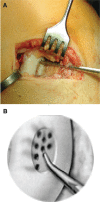Autologous Matrix-Induced Chondrogenesis (AMIC): Combining Microfracturing and a Collagen I/III Matrix for Articular Cartilage Resurfacing
- PMID: 26069536
- PMCID: PMC4440611
- DOI: 10.1177/1947603509360044
Autologous Matrix-Induced Chondrogenesis (AMIC): Combining Microfracturing and a Collagen I/III Matrix for Articular Cartilage Resurfacing
Abstract
Options for the treatment of cartilage defects include chondral resurfacing with abrasion, debridement, autologous chondrocyte transplantation (ACT), matrix-induced chondrocyte transplantation (MACI), or osteochondral autologous transplantation (OATS). This article describes the new method of autologous matrix-induced chondrogenesis (AMIC), a 1-step procedure combining subchondral microfracture with the fixation of a collagen I/III membrane by a partially autologous fibrin glue. Indications and contraindications are provided; a technical note is given. This method is primarily applied in osteochondral lesions of the knee and ankle joints; other joints may qualify.
Keywords: AMIC; autologous cartilage repair; microfracturing.
Conflict of interest statement
Figures




References
-
- Britberg M. Autologous chondrocyte implantation—technique and long-term follow-up. Injury. 2008;39 Suppl:S40-9. - PubMed
-
- Mithoefer K, Wiliams RJ, Warren RF, Potter HG, Spock CR, Jones EC, et al. The microfracture technique for the treatment of articular cartilage lesions in the knee: a prospective cohort study. J Bone Joint Surg Am. 2005;87:1911-20. - PubMed
-
- Steadman JR, Briggs KK, Rodrigo JJ, Kocher MM, Gill TJ, Rodhen WG. Outcomes of microfracture for traumatic chondral defects of the knee: average 11-year follow-up. Arthroscopy. 2003;15(5):477-84. - PubMed
-
- Steadman JR, Rodkey WG, Rodrigo JJ. Microfracture: surgical technique and rehabilitation to treat chondral defects. Clin Orthop Relat Res. 2001;391 Suppl:S362-9. - PubMed
-
- Bartlett W, Skinner JA, Gooding CR, Carrington RWJ, Flanagan AM, Briggs TWR, Bentley G. Autologous chondrocyte implantation versus matrix-induced autologous chondrocyte implantation for osteochondral defects of the knee: a prospective randomized study. J Bone Joint Surg Br. 2005;87(B):640-5. - PubMed
LinkOut - more resources
Full Text Sources

